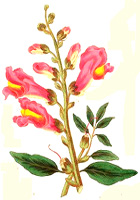In my last post I had a mystery plant which was identified by Tina and Annie as Celandine Poppy, Stylophorum diphyllum . Thanks ladies! This led me on a search for other pictures to compare my plant to and most all of them were of a plant/weed that grows all over here that I had no name for. It's pretty and welcome in the wildflower areas but when it gets into the garden it threatens to take over. There were a few pictures that looked like my mystery plant.
Here's a closer look at both the flowers and the leaves.
After looking up Celandine Poppy and finding links referring to Wood Poppy my brain finally clicked and I do remember picking up a seedling at a plant sale last September. I still don't remember planting it though. Here's a better picture. Both the flower and the leaves do look very similar but slightly different to the flowers I'm used to.
My confusion continued as I continued to find pictures of both plants all labeled with the same name. Then I happened across the Appalachian Cultural Museum site where I found this:
You can often find a similar plant growing along roadsides and other disturbed areas. It was introduced from Europe. This is the Celandine (Chelidonium majus). It differs from the Celandine Poppy in having smaller flowers and smooth fruits which do not retain the styles.
With two plants with virtually the same name it's no wonder they get mixed up!














Well my guess was wrong but at least it sent you in the right direction to ID your pretty yellow thug, Apple!
ReplyDeleteDoncha love the way one word in a search engine can disappear several hours out of your life? But admittedly in an enjoyable way ;-]
Annie at the Transplantable Rose
I was introduced to Stylophorum diphyllum this spring as I dug some from the nursery owner's garden and transplanted it into nursery pots to prepare it for sale. Since then a client I garden for gave me several volunteers of hers that had established themselves between her courtyard pavers. I'm looking forward to adding them to my shade garden when they're ready to leave their holding pots.
ReplyDeleteI found your post while googling these plants to learn more about them before they go into my garden. I was a bit confused myself while reading. Then I came upon your blog. Thanks for clearing up the confusion. I'm glad I have the native rather than the European invasive variety. Any seedlings of Stylophorum diphyllum will be welcome in my garden and will be used to populate other areas and share with family, friends, and clients.
I learned through googling that there are only two small areas in Illinois, and one of them is Cook County where I live, where Stylophorum diphyllum is found in Illinois woodlands. I'm looking forward to adding it my garden!